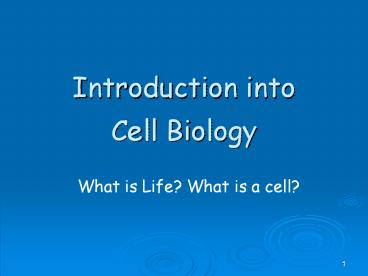Introduction into Cell Biology - PowerPoint PPT Presentation
1 / 40
Title:
Introduction into Cell Biology
Description:
Introduction into Cell Biology What is Life? What is a cell? * * * * * * * * * * * * * * * * * * * Intro into Cell Biology BACTERIAL PATHOGENS Bacillus anthracis ... – PowerPoint PPT presentation
Number of Views:869
Avg rating:3.0/5.0
Title: Introduction into Cell Biology
1
Introduction into Cell Biology
What is Life? What is a cell?
2
Intro into Cell Biology
-gt All living organisms are made out of cells -gt
Cells are the smallest living unit
Human egg cell sperm
3
Intro into Cell Biology
Single cell organisms Multi cell organisms -gt
Single cell organisms -gt Microorganisms
Yeast - Fungi
Bacteria
Archea
4
Intro into Cell Biology
Single cell organisms Multi cell organisms -gt
multi cell organisms -gt higher degree or
organization of cells within the organism -gt
specialization of cells
Human red blood cells
Plant cells
Human skin cells
5
Intro into Cell Biology
Size of the cells
6
Intro into Cell Biology
Evolutionary time line
7
Intro into Cell Biology
Classification of Cells
8
Intro into Cell Biology
Two cell types - The Three Domain System
Prokaryotes
9
Intro into Cell Biology
Cell Types
10
Intro into Cell Biology
Prokaryotes Domain Bacteria
-gt Single cell organisms -gt No nucleus, no
compartments -gt Peptidoglycan cell walls -gt
Binary fission -gt For energy, use organic
chemicals, inorganic chemicals, or photosynthesis
11
Intro into Cell Biology
Prokaryotes Domain Archea
-gt Lack peptidoglycan -gt Live in extreme
environments Include Methanogens Extreme
halophiles Extreme thermophiles -gt Role in
disease not well understoodthis group has only
recently been discovered
Thermophiles growing in Yellowstone hot springs.
12
Intro into Cell Biology
Life on Mars?
Magnified view of objects in Martian meteorite
found in Antarctica. (Archaeobacteria like?)
13
Intro into Cell Biology
Domain Eukaryotes
-gt Plantae multicellular plants, cellulose
cell wall, photosynthesis -gt Fungi Chitin cell
walls Use organic chemicals for energy Molds and
mushrooms are multicellular consisting of masses
of mycelia, which are composed of filaments
called hyphae -gt Protists Protozoa, motile via
pseudopods, cilia, or flagella Algae,
photosynthetic -gt Animalia Multicellular animals,
Parasitic flatworms and round worms are called
helminthes. Microscopic stages in life cycles
14
Fungi
Intro into Cell Biology
Slime mold
Yeast
15
Fungi
16
Protozoa
Intro into Cell Biology
Amoeba
Euglena
Paramecium
17
Protozoa - Algae
Intro into Cell Biology
18
Intro into Cell Biology
Viruses -gt are NO living organisms -gt parasites
-gt Consist of DNA or RNA core -gt Core is
surrounded by a protein coat -gt Coat may be
enclosed in a lipid envelope -gt Viruses are
replicated only when they are in a living
host cell -gt Not cellular
19
Intro into Cell Biology
Cell growth -gt cell division
Cell death -gt apoptosis
20
Intro into Cell Biology
Cell Movement -gt Motility -gt Flagellum
Pseudomonas (3,300X)
Salmonella (1200X)
21
Intro into Cell Biology
Cell Movement -gt Motility -gt Flagellum
22
Intro into Cell Biology
Microorganisms are important for Food production
23
Intro into Cell Biology
Microbes at Work
1. Agriculture - used to control crop
insects. 2. Bioremediation - a field of
environmental biotechnology where bacteria are
used to clean up toxic wastes. Ex. Oil
spills. 3. Pharmacology - developing
anti-microbics (antibiotics and other
chemotherapeutic substances) to destroy
pathogens. 4. Vaccines - developing weakened
strains of pathogenic bacteria or viruses in
order to protect (immunize) against
infection. 5. Snow for ski resorts (artificial)
24
Intro into Cell Biology
Microbes at Work
clean up of Oil spills.
25
Intro into Cell Biology
Microbes at Work
6. Forensics - analyzing DNA left as
evidence in criminal investigations (PCR
test). 7. Genetic engineering - transfer of
genes (DNA) from one organism to another 8.
Bioinformatics - the application of computer
information science to complex biological
problems (genomics, proteomics, glycomics)
26
Intro into Cell Biology
Medical Microbiologi Infectious diseases
Nearly 2,000 different microbes cause
diseases. 10 B new infections/year worldwide 13
M deaths from infections/year worldwide
27
Intro into Cell Biology
Medical Microbiologi Infectious diseases
28
Intro into Cell Biology
Medical Microbiologi Infectious diseases
29
Louis Pasteur (1822-1895)
- Showed microbes caused fermentation and spoilage
- Disproved spontaneous generation of
microorganisms - Developed pasteurization
- Demonstrated what is now known as Germ Theory of
Disease - Developed a rabies vaccine
Insert figure 1.11
30
Robert Koch (1843-1910)
- Established Kochs postulates - a sequence of
experimental steps that verified the germ theory - Identified cause of anthrax (Bacillus anthracis),
Tuberculosis (Mycobacteria tuberculosis), and
cholera (Vibrio cholerae) - Developed pure culture methods
Insert figure 1.12
31
Intro into Cell Biology
32
Intro into Cell Biology
BACTERIAL PATHOGENS
33
Intro into Cell Biology
BACTERIAL PATHOGENS
Yersinia pestis
Neisseria meningitis
B. burgdorferi
Borrellia -gt Lyme disease
34
Intro into Cell Biology
BACTERIAL PATHOGENS
Clostridium botulinum. CDC. C. tetani -gt tetanus
Bacillus anthracis
Corynebacterium diphtheriae
Staphylococcus aureus
35
Intro into Cell Biology
BACTERIAL PATHOGENS
-gt Typhus
36
Intro into Cell Biology
BACTERIAL PATHOGENS
Mycoplasma fungus-form
-gt pneumonia The smallest bacteria - 0.2
micrometers
-gt Pneumonia, Blindness
37
Intro into Cell Biology
VIRAL PATHOGENS
HIV
Ebola
Smallpox
Rabies virus
38
Intro into Cell Biology
EUKARYOTIC PATHOGENS
Giardia lamblia gt chronic diarrhea
Plasmodium vivax
-gt Malaria
Trichomonas vaginalis vaginosis in females and
urethritis in males.
39
Fig. 1.3. Emerging infectious diseases
40
Intro into Cell Biology
Cyanobacteria
Cyanobacteria bloom
Photosynthetic, formerly blue-green algae. 2
H2O CO2 sunlight ? CH2O H2O O2
Formed O2 in the
earths atmosphere. Important nitrogen-fixers.





![[PDF] Molecular Biology of the Cell Free PowerPoint PPT Presentation](https://s3.amazonaws.com/images.powershow.com/10081897.th0.jpg?_=202407190210)

























